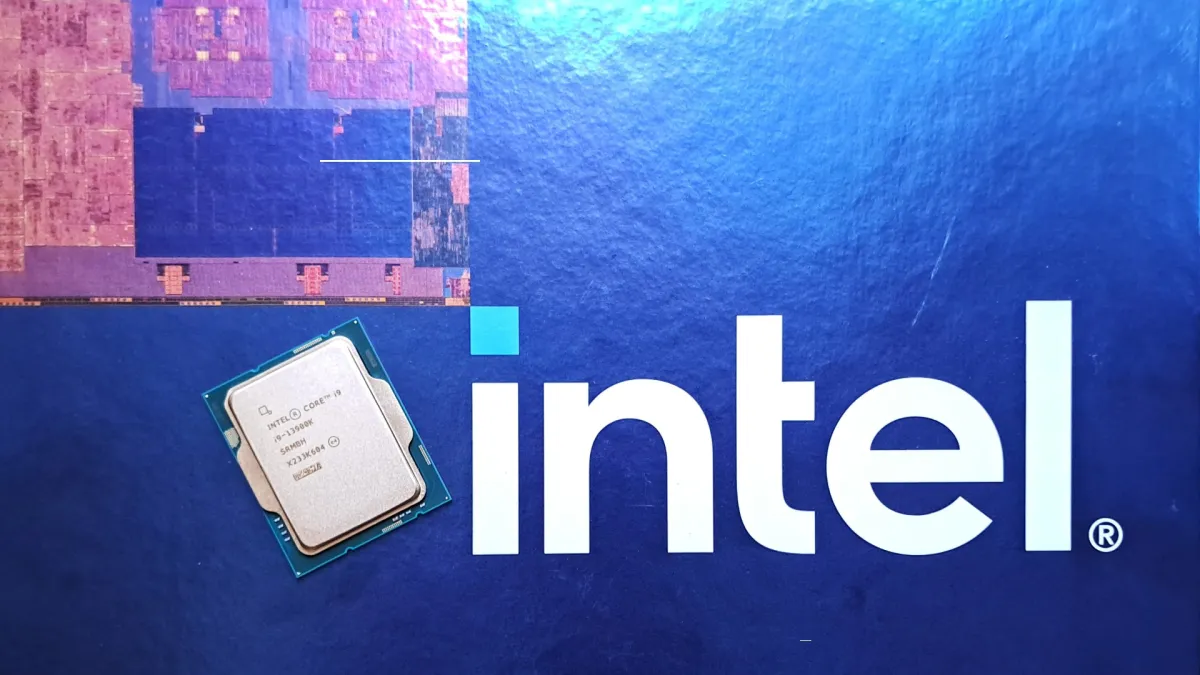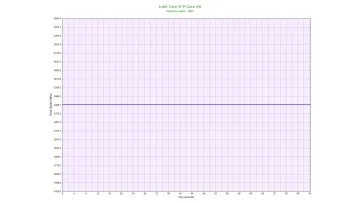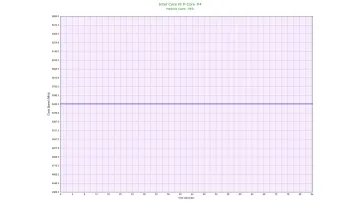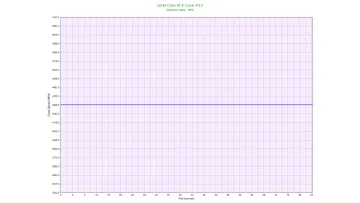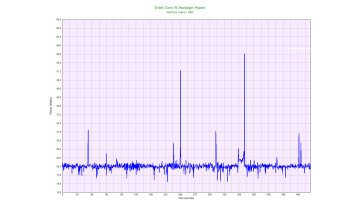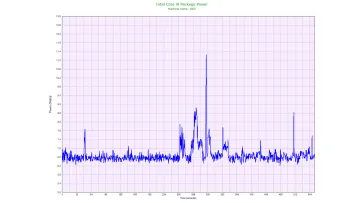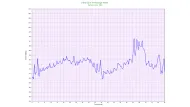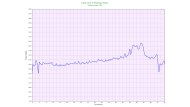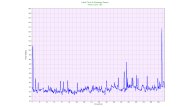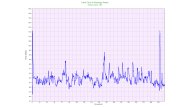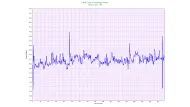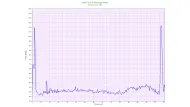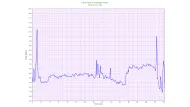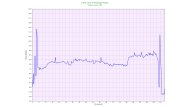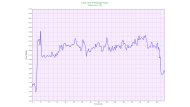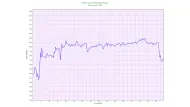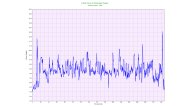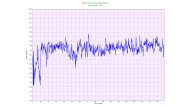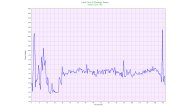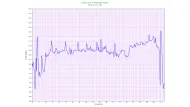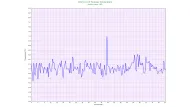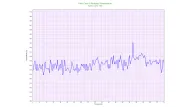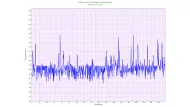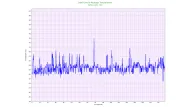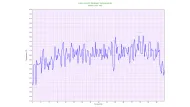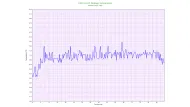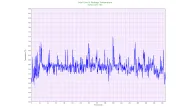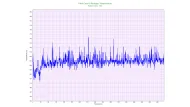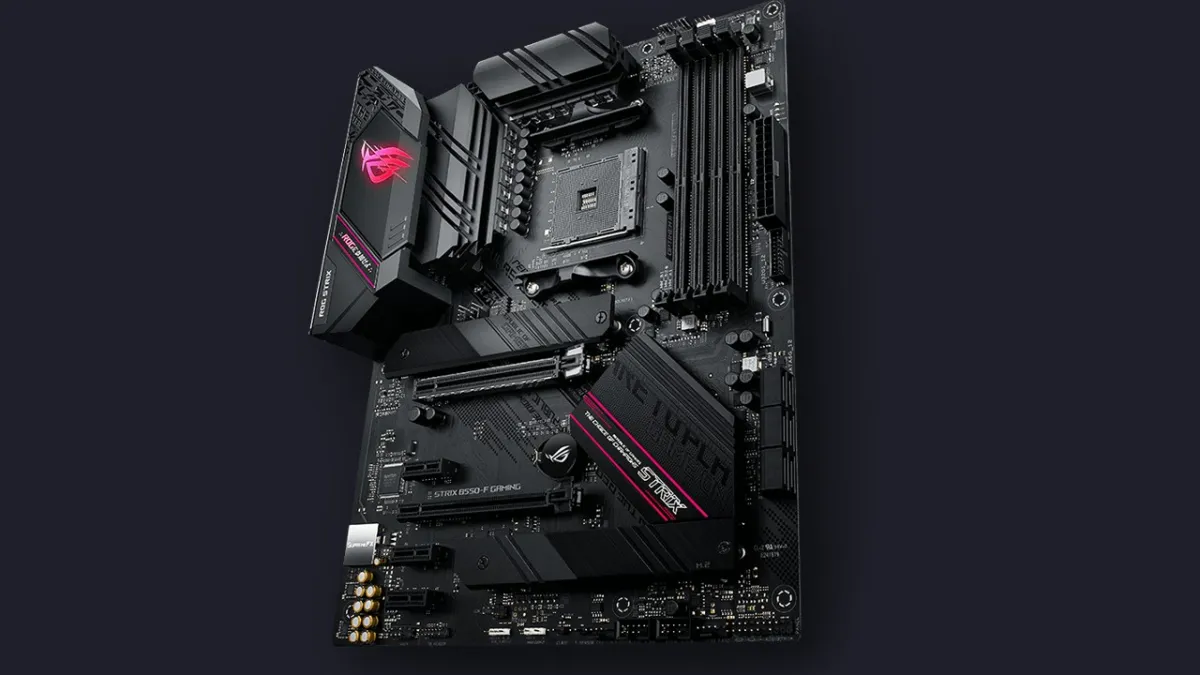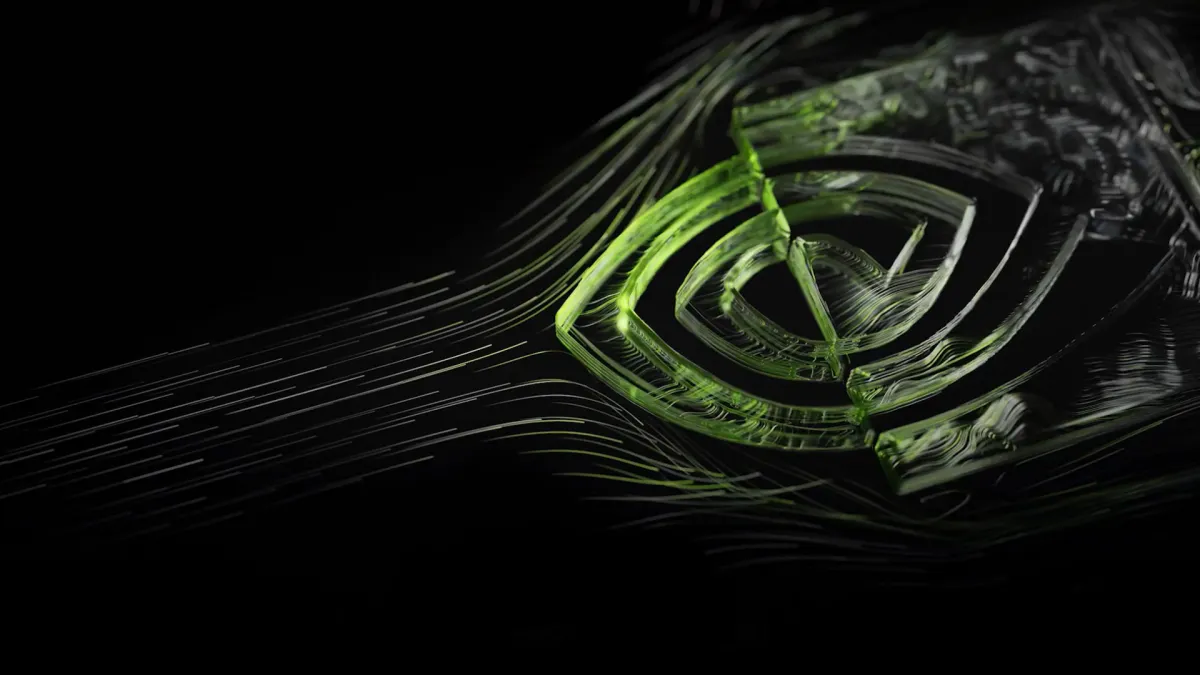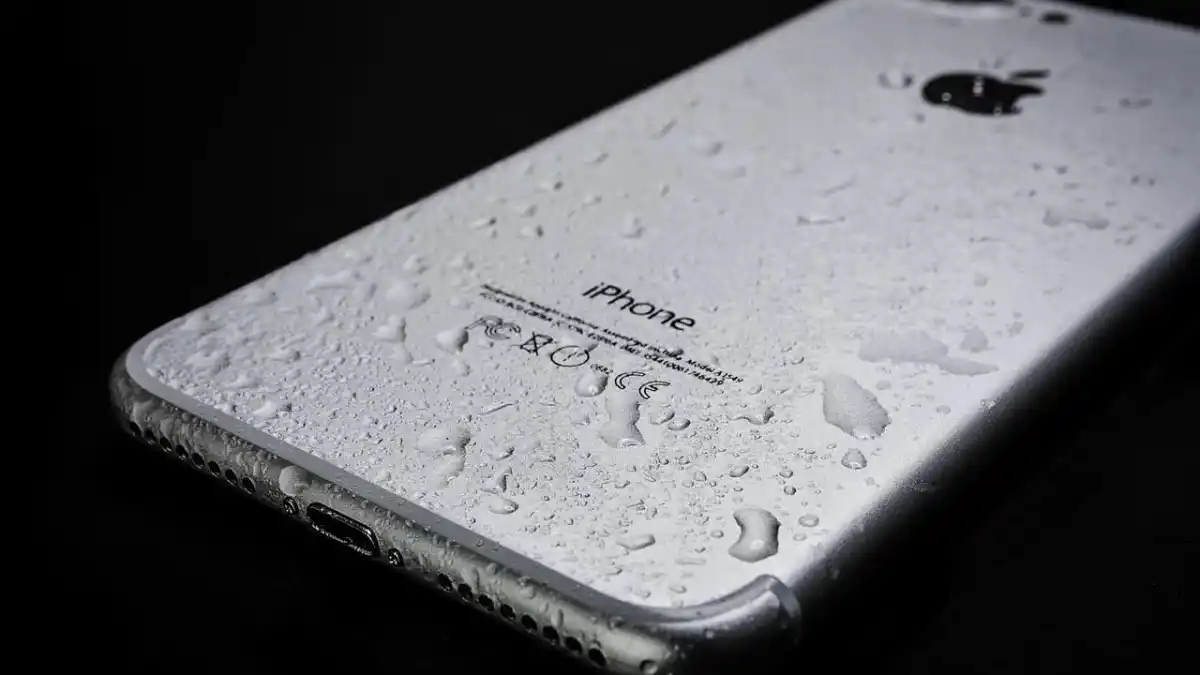Frequencies
For the past several generations, high frequencies have been a major marketing point for Intel CPUs. These high frequencies traditionally translate to better gaming performance, though this isn’t always the case since IPC, cache, core counts, and other things improve framerates as well. For the 13th generation, Intel focused on larger frequency increases for the i9, but the larger L2 cache, and a small IPC improvement help to increase performance as well. Intel advertises the 13900K as a CPU capable of boosting up to 5.8 GHz on its P-cores and 4.3 GHz on its E-cores.
We used the in-game Cyberpunk 2077 benchmark with uncapped framerates in 1080p on low settings with DLSS Ultra Performance mode enabled (to reduce GPU bottlenecking) to perform some basic gaming frequency tests on the 13900K. We allowed the game to run for 10 minutes and heat up the processor before capturing data and then recorded the frequency behaviors for both the P-cores and E-cores. The game averaged 189 fps under these conditions and average CPU usage was surprisingly low at a maximum of just 30%. We clearly experienced some system bottlenecks, but there are also likely some game engine limitations going on here as well.
Editor’s note: We decided to cross-validate these results and reached the same frequency results in multiple games including Dying Light 2 and Call of Duty: Warzone and elected to publish the Cyberpunk results despite the engine oddities.
Under these test conditions, the 13900K yielded sustained minimum clocks speeds of 5.49GHz on all P-cores while gaming. This did not live up to the advertised 5.8 GHz boost Intel advertises for the i9, however, there’s more to it than that.
- P-Core 5.49GHz
- P-Core 5.49GHz
- E-Core 4.29GHz
At idle, we can see the frequency behavior bounces between 5.49 and 5.79 GHz frequently. Setting the H150i liquid cooler pump and fan speeds to “Extreme” stabilized the frequency further. The 13900K struggles to maintain this frequency though, meaning Intel’s claim is technically accurate, but not accurate in this practical use test. Keep in mind the 13900K we tested was configured to overclock and draw more power wherever required. Intel’s 7 node appears to be pushed to the limit and essentially overclocked out of the box. In comparison to the 12900K, the best it can do is a somewhat stable 5.3GHz all-core clock speed on all P-Cores.
It’s a better story for the E-cores though, which are far faster this gen and stable at 4.29GHz. That’s an increase of 400MHz in one gen, and frequency stability is the most impressive part since it’s also across all E-Cores. While these cores aren’t currently useful for gaming, the increased frequencies should be taken note of. Games may be able to benefit from the E-cores for gaming workloads in the not-too-distant future if Intel keeps pushing its Hybrid architecture forward at this rapid pace.
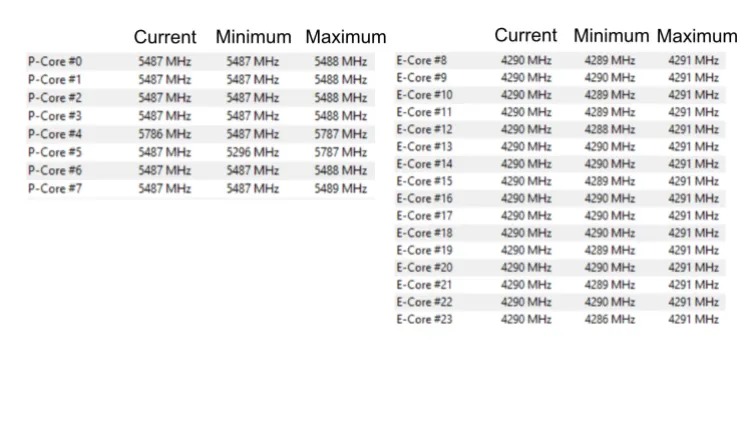
Note that P-Core #4 hit 5,786 MHz when we took the screenshot, but the frequency wasn’t attainable in our game test.
To conclude on frequencies, The Raptor Lake architecture allows the 13900K to run at a stable 5.49GHz on all cores, only with brief boosts under light load to 5.79GHz even on a 360mm liquid cooler. It’s a clear step up from the previous gen, but it’s not to be misrepresented as a genuine 5.8GHz CPU for long gaming sessions.
Power consumption
Power consumption is generally up yet again with Intel’s 13th gen compared to all previous generations. In the case of the 13900K, the official maximum power before overclocking is advertised as 253W. The 13900K can also be configured to a 125W mode in the BIOS if you are willing to sacrifice some performance to nearly half the power draw. Considering the high costs of energy in some countries today, some may consider doing this.
We test at full power for several reasons. The obvious reason is that most gamers prefer maximum performance. Motherboard manufacturers also typically enable these maximum power limits by default. Lastly, Intel’s own benchmarks for marketing are based on maximum performance settings.
The maximum power consumption that a processor is able to draw is often confused with what it will actually use in real world use cases. The is particularly true with many games, and only the most demanding titles push a CPU anywhere close to its maximum power consumption. Instances of high power consumption are more often associated with multi-threaded workload applications such as rendering or CPU stream encoding while gaming.
For gaming, CPUs typically exhibit power spikes when games launch and the engines load, but power consumption tends to trend downward for normal gameplay. You’ll typically see power consumption fluctuate as things happen during gameplay like when moving around levels or open worlds, experiencing in-game events like waves of enemies spawning in, complex actions taking place, etc.
- Idle Maximum Performance.
- Idle Power Saver.
Before we get to the game data, here is what to expect out of the 13900K at idle on Windows 11. The processor averaged roughly 20.6W with all power consumption preferences set to maximum. This idle power consumption can be reduced to a mere 6.6W average with the default Windows Power Saver plan. Under this power plan, the 13900K retained a reasonable degree of system responsiveness and averaged 10.2W under light work use. We gathered the data while writing this review and switching between apps like Slack, Discord, and the Affinity Photo editing software. Everything remained snappy and responsive. If you are worried about high energy costs, this processor will not be an issue for daily use, especially if configured to be efficient.
Gaming power consumption
Unlike when we tested the 12900K last year, we found that the 13900K doesn’t exhibit high power consumption in any gaming workloads. The worst offender was Cyberpunk 2077, but CDPR has either optimized the game engine better, Microsoft has tweaked Windows 11, or Intel has made some adjustments on its side via microcode updates in the newer BIOS version we used. Both the 12900K and 13900K pull much less power in Cyberpunk 2077 now. Intel processors still exhibit some noteworthy power spikes, but these are brief and often significant outliers from the average power consumption values. As we’ll show, the 13900K can run games at a range of popular framerates without getting anywhere near the 253W Max TDP.
Games are anything but consistent workloads. As such, we use graphs that show the behavior of the 13900K over time. First up is the Cyberpunk 2077 benchmark, which we chose due to it being an intensive, dense, open-world title that’s built on the DirectX 12 API. For context, DirectX 12 is able to spread out workloads across more cores, resulting in better hardware utilization and better framerates. In turn, this pushes the CPU to draw more power.
Refer to our gaming performance section of the review for the exact settings and test conditions. For Cyberpunk 2077, we performed two types of tests. The first test uses a locked framerate at 60 fps, and the other runs with uncapped framerates to let the 13900K consume more power.
Cyberpunk 2077:
- 60 fps.
- Uncapped framerate (179.1 fps avg).
Cyberpunk 2077 is a case where all eight P-cores for the 13900K are tapped to deliver more consistent framerates and smoother feeling performance. At 60 fps, the 13900k averaged just 77.5W with a peak power draw of 93.4W. In the uncapped framerate test which averaged 179.1 fps, power consumption averaged 133.2W with a peak power draw of 148.1W. For additional context, we also logged a peak power draw of 165W outside of the benchmark while loading the game engine during game startup.
We’ve also included some additional games to give you a general idea of how much power the 13900K draws. These include Fortnite gameplay and the Tiny Tina’s Wonderlands benchmark. For additional context, we tested at locked framerates based upon the popular framerates of 60 and 144 and then did a test with uncapped framerates.
Fortnite:
- 60 fps.
- 144 fps.
- Uncapped framerate (417.5 fps avg).
Tiny Tina’s Wonderlands:
- 60 fps.
- 144 fps.
- Uncapped framerate (287.5 fps avg).
Gaming and multi-tasking power consumption
What if you like to run more programs alongside your games though? Perhaps you like to stream, record gameplay, use social apps, run peripherals with high polling rates, and more while playing your games. To push the 13900K power consumption to the max, we also performed the same power measurements tests with some additional applications going in what we call our “multi-tasking test.”
For this test, we run the games on the lowest settings with DLSS Performance where available to push the CPU harder. Alongside this, we run Chrome with a YouTube video playing in the background, Slack, Discord, Affinity Photo editor, the Epic Games Store, Steam, Origin, GeForce Experience Instant Replay, OBS Studio encoding in x264 format at 1080p 60 fps via CBR with a bitrate set at 5000Kbps (similar to a high quality stream), and iCUE with Axon hyper-polling in use and set to 4,000Hz for both the mouse and keyboard.
This is a bloated test and obviously not recommended if your goal is to maximize framerates while, say, streaming a game to something like Twitch. But it is interesting to see how much power can be used for gaming-related purposes. We’ve included results from the same three games (Cyberpunk 2077, Fortnite, and Tiny Tina’s Wonderlands) for comparison. (For more information on test conditions, refer to the “gaming performance and multi-tasking” section in this review).
For the multi-tasking power consumption tests, we used 60 fps as a basis and additionally tested at uncapped framerates to maximize power draw and also give high-refresh enthusiasts a better idea of what to expect.
Cyberpunk 2077:
- 60 fps.
- Uncapped framerate (132.2 fps avg).
Fortnite:
- 60 fps.
- Uncapped framerate (247.0 fps).
Tiny Tina’s Wonderlands:
- 60 fps.
- Uncapped framerate (248.2 fps avg).
As we can see from these tests, the 13900K still doesn’t get anywhere near the 253W power limit when handling additional applications related to gaming. During all of our testing, the 13900K remained very efficient even when capturing gameplay and using hyper-polling. The maximum power draw we recorded during the entire testing session was 176.4W.
To wrap up the 13900K gaming power consumption, we are very impressed with what Intel’s achieved with the 13th gen Raptor Lake lineup even on its most power-hungry CPU. It’s more efficient than our results from last year when testing the 12th gen Alder Lake lineup, and we consider it to be a reasonably efficient gaming CPU in practical terms. Just keep in mind this review doesn’t apply to power efficiency in other workloads like productivity. If you plan to do that, you’ll want to find reviews that test those applications.
Temperatures
The importance of a good cooling setup cannot be understated for those interested in achieving maximum performance out of their CPU. This is particularly true for anyone planning to use a modern i9. As already stated, we used a 360mm Corsair H150i Elite liquid cooler for all of our testing and it easily kept the 13900K in check.
We tested two games at two different framerate settings for two total rounds of testing to gather our thermal results. We selected Cyberpunk 2077 as the heavyweight title and Fortnite as a lightweight alternative. Just like in our power consumption tests, we tested each game at locked 60 fps and again with uncapped framerates. Each game was benchmarked under basic conditions, and then again under multi-tasking conditions to see how much additional power consumption was required and how much additional heat was generated.
Here’s a basic rundown of our testing conditions. The 360mm Corsair Elite H150i cooler was set to the default “Balanced” fan curves and water pump presets. Ambient temperatures were at 69F (21C). We applied Thermal Grizzly Kryonaut thermal paste to the CPU. More information about how exactly we test the games can be found in the gaming performance section. You can refer to the first page of the review for more information about the hardware.
Gaming temperatures
Here’s a quick look at how the 13900K temperatures measured out while just gaming.
Cyberpunk 2077:
- Locked 60 fps.
- Uncapped framerate (179.1 fps avg).
Fortnite:
- 60 fps.
- Uncapped framerate (417.5 fps avg).
In the gaming tests, the temperatures were all within an acceptable range across the 24 cores. We regularly observed temperatures in the high 60s (Celsius), with the occasional, brief spikes into the mid 70s on specific P-Cores. Package temperatures remained within acceptable ranges under isolated gaming conditions, so most users should be able to get by with a 240mm liquid cooler if they are capping framerates. However, 360mm is recommended if pairing the 13900K with a high-end system and graphics card such as the RTX 4090 and if you intend to play at or above 240 fps or with uncapped framerates.
Gaming and multi-tasking temperatures
Here’s how the i9-13900K temperatures stand up to gaming while under additional load from other applications. We performed our same multi-tasking test described in the power consumption section to gather the data.
Cyberpunk 2077:
- 60 fps.
- Uncapped framerate (132.2 fps).
Fortnite:
- 60 fps.
- Uncapped framerate (__)
Temperature differences weren’t all that worse throughout the multi-tasking tests. This can likely be attributed to the larger die size to spread out the heat better than the previous gen 12900K, and what appear to be efficiency improvements from the architecture and operating system. Our same recommendation of using a 360mm liquid cooler applies here if you plan to use the 13900K for intense gaming plus streaming workloads plus obviously any other productivity tasks that tap into the higher power consumption levels the processor is capable of pulling.
- Introduction, features, and specs
- Frequencies, power consumption, and temperatures
- Gaming performance and multi-tasking
- Pricing and conclusion

